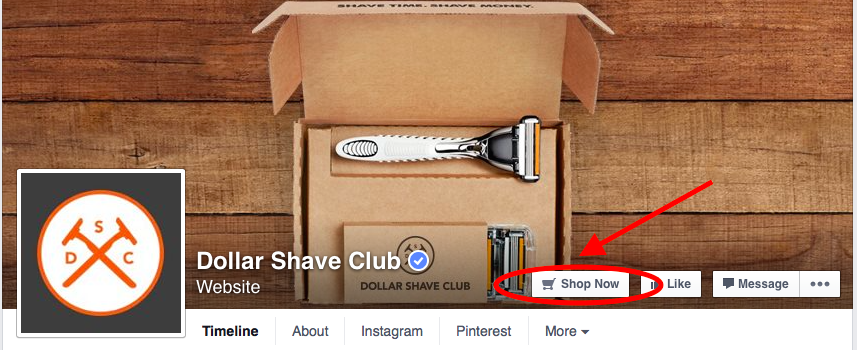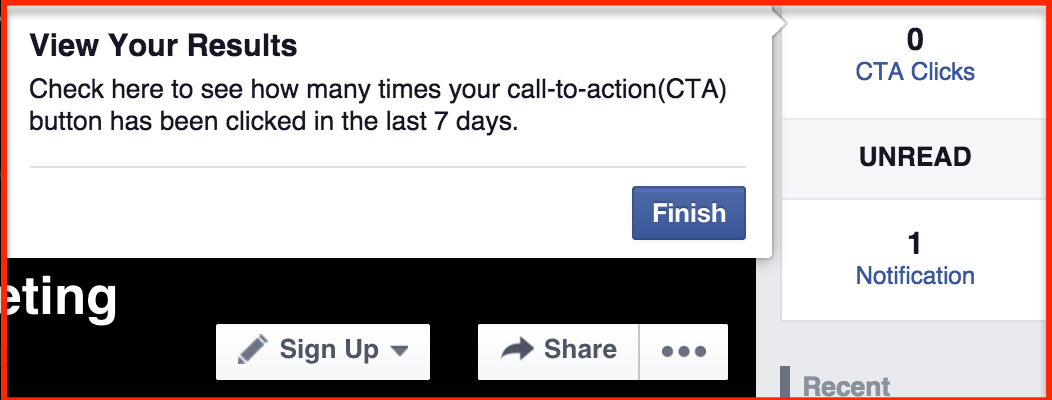Using Facebook for your small business is a great way to build brand awareness and loyalty. But how can you keep your social followers engaged and encourage them to take action with your brand, all from your Facebook page?
Adding the new call-to-action button to your page is a great way to highlight your objective, whether that’s getting your fans to make a purchase online or to sign up for your email list. Including an action allows you to not only connect with your audience, but also provides them with an opportunity to become a new or more loyal client.
Page admins can select from a group of call-to-action buttons — like Shop Now or Sign Up — to add to the top of their Page.
How to Use Facebook’s Call-to-Action Buttons to Increase Revenue
Facebook provides 7 calls-to-action buttons that you can use. They include:
- Email Sign Up: Grow your subscriber list by encouraging your social followers to subscribe to your emails. You can link to a web hosted version of your email sign up form.
- Shop Now: Looking to increase sales? Direct your followers to your online website or a featured product page. Don’t forget to integrate your shopping cart with your email service provider to continue collecting more subscribers!
- Contact Us: Provide your audience with a way to ask you questions about your company or products.
- Watch Video: Promote a company video or commercial right at the top of your Facebook business page.
- Book Now: Have an upcoming event? Give your followers easy access to purchase tickets or reserve a spot.
- Play Game: Create a fun experience for your social followers by sending them to a branded game you created.
- Use App: Encourage your followers to use your Facebook app or mobile app.
Here’s what the Call-to-Action button will look like on your page (Facebook provides stats in the sidebar for how many people click the button). You can use your Call-to-Action button to link anywhere you would like to drive traffic.

What’s the smartest CTA for your marketing objectives?
You’ll have to decide that based on what your marketing goals are for your business. But you can definitely use different calls-to-action at different times to add variety to your business page.
How to Set It Up
Once you’ve determined how you want to use your call-to-action button, setting it up is easy! Simply select the button you want and enter the website URL where you would like to redirect your followers.
Get Your Call-To-Action Button Noticed
Let your creativity shine and consider ways to use your cover photo to draw attention to your call-to-action button. Try featuring an incentive your followers can get if they take action, or draw their attention with an arrow pointing towards the button. For example, offering a free eBook when new subscribers sign up is a great way to entice visitors to notice your call-to-action button, and engage with you.
Tracking: View How Many Times Your CTA Button Has Been Clicked
Once you’ve set up your button, you’ll likely want to track how well it’s performing. There are two ways you can access this data:
- Simply hover over your CTA button, then over ‘See Insights’
- Go to the ‘This Week’ section on the right side of your Page, and look at ‘CTA clicks’

Data will be shown for the past 7 days, so you will have to allow some time to pass between setting up your button and having access to up-to-date stats. But this is best so that you don’t make a snap decision. Take a data sample based on at least a week of performance. Keep in mind that different CTA buttons will likely perform differently depending on your industry and audience. For instance, a ‘Sign Up’ button likely won’t perform the same for an e-commerce site as they would for a content-based site. Alternatively, a ‘Shop Now’ button would do little for an education based blog, but would attract visitors to a sale at your eCommerce store.
Outside of Facebook, you can use Google Analytics to track the events of the users that are coming to your landing pages. In addition, once you have your demographics options enabled in Google Analytics, you can begin to track the type of visitor, their locations, interests and average ages. Know this information will help you better understand the visitors that you are attracting, and help you to convert more of these visitors into customers.
Related: Using Demographics in Google Analytics to Increase Conversions
Test Out a Variety of Buttons
As mentioned above, how well each button performs will depend on your business objectives, industry and audience. Because of this, it’s important to test out different buttons for at least a week to see which ones perform best. Continue testing the buttons over time to keep in line with changes to your audience or goals. As you audience grows, you may see differences in the types of visitors and subscribers that you are seeing, and different CTA buttons will show different results based on this factor. It’s always important to be split testing, and let the numbers answer your questions. Here’s more information on Split testing:
Related: 6 A/B Tests You Should Be Using on Your Website
If you’re not using Facebook’s Call-to-Action buttons, now is the time to start. There’s no reason to not add this valuable tool to your Fan Page. If you can muster 10-15 minutes a week to track the data that it will provide you, you’ll be able to convert a much higher rate of your fans into customers.
Are you using Facebook’s CTA buttons yet? How are they performing so far? Share below!
Topics: Social Media Marketing
Using Facebook for your small business is a great way to build brand awareness and loyalty. But how can you keep your social followers engaged and encourage them to take action with your brand, all from your Facebook page?
Adding the new call-to-action button to your page is a great way to highlight your objective, whether that’s getting your fans to make a purchase online or to sign up for your email list. Including an action allows you to not only connect with your audience, but also provides them with an opportunity to become a new or more loyal client.
Page admins can select from a group of call-to-action buttons — like Shop Now or Sign Up — to add to the top of their Page.
How to Use Facebook’s Call-to-Action Buttons to Increase Revenue
Facebook provides 7 calls-to-action buttons that you can use. They include:
- Email Sign Up: Grow your subscriber list by encouraging your social followers to subscribe to your emails. You can link to a web hosted version of your email sign up form.
- Shop Now: Looking to increase sales? Direct your followers to your online website or a featured product page. Don’t forget to integrate your shopping cart with your email service provider to continue collecting more subscribers!
- Contact Us: Provide your audience with a way to ask you questions about your company or products.
- Watch Video: Promote a company video or commercial right at the top of your Facebook business page.
- Book Now: Have an upcoming event? Give your followers easy access to purchase tickets or reserve a spot.
- Play Game: Create a fun experience for your social followers by sending them to a branded game you created.
- Use App: Encourage your followers to use your Facebook app or mobile app.
Here’s what the Call-to-Action button will look like on your page (Facebook provides stats in the sidebar for how many people click the button). You can use your Call-to-Action button to link anywhere you would like to drive traffic.

What’s the smartest CTA for your marketing objectives?
You’ll have to decide that based on what your marketing goals are for your business. But you can definitely use different calls-to-action at different times to add variety to your business page.
How to Set It Up
Once you’ve determined how you want to use your call-to-action button, setting it up is easy! Simply select the button you want and enter the website URL where you would like to redirect your followers.
Get Your Call-To-Action Button Noticed
Let your creativity shine and consider ways to use your cover photo to draw attention to your call-to-action button. Try featuring an incentive your followers can get if they take action, or draw their attention with an arrow pointing towards the button. For example, offering a free eBook when new subscribers sign up is a great way to entice visitors to notice your call-to-action button, and engage with you.
Tracking: View How Many Times Your CTA Button Has Been Clicked
Once you’ve set up your button, you’ll likely want to track how well it’s performing. There are two ways you can access this data:
- Simply hover over your CTA button, then over ‘See Insights’
- Go to the ‘This Week’ section on the right side of your Page, and look at ‘CTA clicks’

Data will be shown for the past 7 days, so you will have to allow some time to pass between setting up your button and having access to up-to-date stats. But this is best so that you don’t make a snap decision. Take a data sample based on at least a week of performance. Keep in mind that different CTA buttons will likely perform differently depending on your industry and audience. For instance, a ‘Sign Up’ button likely won’t perform the same for an e-commerce site as they would for a content-based site. Alternatively, a ‘Shop Now’ button would do little for an education based blog, but would attract visitors to a sale at your eCommerce store.
Outside of Facebook, you can use Google Analytics to track the events of the users that are coming to your landing pages. In addition, once you have your demographics options enabled in Google Analytics, you can begin to track the type of visitor, their locations, interests and average ages. Know this information will help you better understand the visitors that you are attracting, and help you to convert more of these visitors into customers.
Related: Using Demographics in Google Analytics to Increase Conversions
Test Out a Variety of Buttons
As mentioned above, how well each button performs will depend on your business objectives, industry and audience. Because of this, it’s important to test out different buttons for at least a week to see which ones perform best. Continue testing the buttons over time to keep in line with changes to your audience or goals. As you audience grows, you may see differences in the types of visitors and subscribers that you are seeing, and different CTA buttons will show different results based on this factor. It’s always important to be split testing, and let the numbers answer your questions. Here’s more information on Split testing:
Related: 6 A/B Tests You Should Be Using on Your Website
If you’re not using Facebook’s Call-to-Action buttons, now is the time to start. There’s no reason to not add this valuable tool to your Fan Page. If you can muster 10-15 minutes a week to track the data that it will provide you, you’ll be able to convert a much higher rate of your fans into customers.
Are you using Facebook’s CTA buttons yet? How are they performing so far? Share below!
Topics: Social Media Marketing
Published on April 9, 2015


